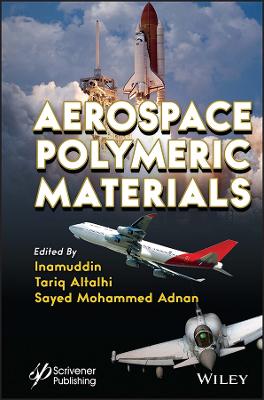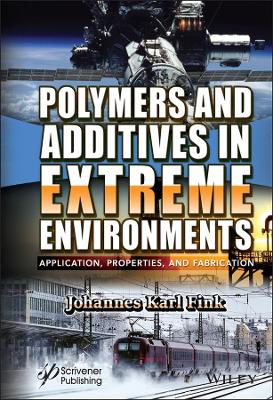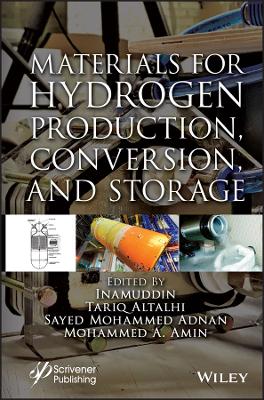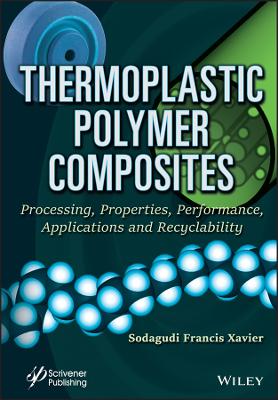Aerospace Polymeric Materials
 -15%
portes grátis
-15%
portes grátis
Aerospace Polymeric Materials
Altalhi, Tariq; Adnan, Sayed Mohammed; Inamuddin
John Wiley & Sons Inc
11/2022
288
Dura
Inglês
9781119904892
15 a 20 dias
666
Descrição não disponível.
Preface xi
1 Tuning Aerogel Properties for Aerospace Applications 1
Catherine Tom, Shubham Sinha, Nidhi Joshi and Ravi Kumar Pujala
1.1 Introduction 1
1.2 Synthesis 3
1.3 Aerospace Missions 6
1.3.1 Stardust Mission 6
1.3.2 MARS Pathfinder Mission 7
1.3.3 Hypersonic Inflatable Aerodynamic Decelerator 7
1.3.4 Mars Science Laboratory 7
1.3.5 Cryogenic Fluid Containment 8
1.4 Property Tuning of Aerogels 8
1.4.1 During Synthesis 9
1.4.2 Post-Synthesis 12
1.4.3 Aerogel Composites 13
1.5 Tuning Properties for Aerospace Applications 15
1.5.1 Thermal Conductivity 15
1.5.1.1 Minimizing Solid Conductivity 16
1.5.1.2 Modification of IR Absorption Properties 16
1.5.1.3 Minimizing Gaseous Conductivity 16
1.5.2 Mechanical Property 17
1.5.3 Optical Transmittance 18
1.6 Conclusion and Future Prospects 18
Acknowledgments 20
References 20
2 Welding of Polymeric Materials in Aircraft 29
Idris Karagoez
2.1 Introduction 30
2.2 Major Polymer Welding Methods Applied in Aviation 32
2.2.1 Hot Gas Welding 34
2.2.2 Hot Plate Welding 36
2.2.3 Extrusion Welding 38
2.2.4 Infrared Welding 39
2.2.5 Laser Welding 41
2.2.6 Vibration Welding 44
2.2.7 Friction Welding 45
2.2.8 Friction Stir Welding 46
2.2.9 Friction Stir Spot Welding 47
2.2.10 Ultrasonic Welding 48
2.2.11 Resistance Implant Welding 50
2.2.12 Induction Welding 51
2.2.13 Dielectric Welding 51
2.2.14 Microwave Welding 54
2.3 Conclusion 55
References 55
3 Carbon Nanostructures for Reinforcement of Polymers in Mechanical and Aerospace Engineering 61
Mahdi ShayanMehr
3.1 Introduction 62
3.2 Common Carbon Nanoparticles 63
3.2.1 Graphene 63
3.2.2 Carbon Nanotubes 63
3.2.3 Fullerenes 64
3.3 Modeling and Mechanical Properties of Carbon Nanoparticles 64
3.4 Modeling of Carbon Nanoparticles Reinforced Polymers 65
3.5 Preparation of Carbon Nanoparticles Reinforced Polymers 69
3.6 Mechanical Properties of Carbon Nanoparticles Reinforced Polymers 70
3.6.1 Graphene Family/Polymer 72
3.6.1.1 Graphite Nanosheets/Polymer 73
3.6.1.2 Graphene and Graphene Oxide/Polymer 75
3.6.2 CNT/Polymer 75
3.6.3 Fullerene/Polymer 76
3.7 Application of Carbon Nanoparticles Reinforced Polymers in Mechanical and Aerospace Engineering 78
3.8 Conclusions 80
References 81
4 Self-Healing Carbon Fiber-Reinforced Polymers for Aerospace Applications 85
Surawut Chuangchote and Methawee Nukunudompanich
4.1 General Principle of Self-Healing Composites 86
4.1.1 Extrinsic Healing 86
4.1.2 Intrinsic Self-Healing 88
4.2 Self-Healing Carbon Fiber-Reinforced Polymers 90
4.2.1 Carbon Fiber-Reinforced Polymers (CFRPs) 90
4.2.2 Healing Efficiency 94
4.3 Manufacturing Techniques 95
4.4 Recent Development of Carbon Fiber-Reinforced Polymers in Aerospace Applications 99
4.4.1 Engines 101
4.4.2 Fuselage 102
4.4.3 Aerostructure 104
4.4.4 Coating 106
4.4.5 Other Application 108
4.5 Disposal and Recycling of Self-Healing Carbon Fiber-Reinforced Polymers 108
4.6 Conclusion and Future Challenges 111
References 112
5 Advanced Polymeric Materials for Aerospace Applications 117
Anupama Rajput, Upma, Sudheesh K. Shukla, Nitika Thakur, Anamika Debnath and Bindu Mangla
5.1 Introduction 118
5.2 Types of Advanced Polymers 119
5.2.1 Copolymers 121
5.2.2 Polymer Matrix Composite 121
5.2.3 Properties of Reinforced Materials 122
5.3 Thermoplastics 125
5.4 Thermosetting 126
5.5 Polymeric Nanocomposites 126
5.6 Glass Fiber 130
5.7 Polycarbonates 131
5.8 Applications 131
5.9 Conclusion 133
References 133
6 Self-Healing Composite Materials 137
Huesnueguel Yilmaz Atay
6.1 Introduction 137
6.2 Self-Healing Mechanism 140
6.3 Types of Self-Healing Coatings 142
6.3.1 Passive Self-Healing for External Techniques 142
6.3.1.1 Microencapsulation 142
6.3.1.2 Hollow-Fiber Approach 143
6.3.1.3 Microvascular Network 143
6.3.2 Active Self-Healing Methodology Based on Intrinsic 144
6.3.2.1 Shape Memory Polymers (SMPs) 144
6.3.2.2 Reversible Polymers 144
6.4 Research Areas of Self-Healing Materials 145
6.5 Aerospace Applications of Polymer Composite Self-Healing Materials 146
6.5.1 Aircraft Fuselage and Structure 146
6.5.2 Coatings 148
6.6 Conclusion 150
References 151
7 Conducting Polymer Composites for Antistatic Application in Aerospace 155
Sonali Priyadarsini Pradhan, Lipsa Shubhadarshinee, Pooja Mohapatra, Patitapaban Mohanty, Bigyan Ranjan Jali, Priyaranjan Mohapatra and Aruna Kumar Barick
7.1 Introduction 156
7.2 Conducting Polymer Composites (CPCs) for Antistatic Application in Aerospace 158
7.3 Conducting Polymer Nanocomposites (CPNCs) for Antistatic Application in Aerospace 165
7.4 Conclusions 178
References 179
8 Electroactive Polymeric Shape Memory Composites for Aerospace Application 189
Mamata Singh, Taha Gulamabbas, Benjamin Ahumuza, N.P. Singh and Vivek Mishra
8.1 Introduction 190
8.1.1 Electroactive Polymer 191
8.1.1.1 Electronic EAPs 192
8.1.1.2 Dielectric Elastomer Actuators (DEAs) 193
8.1.1.3 Piezoelectric Polymer 193
8.1.1.4 Ferroelectric EAPs 194
8.1.2 Ionic Polymers 194
8.1.2.1 Carbon Nanotube (CNT) Actuators 194
8.1.2.2 Ionic Polymer Metal Composites 194
8.1.2.3 Carbon Nanotubes 195
8.1.2.4 Ionic Polymer Gels 195
8.2 Shape-Memory Polymers (SMPs) 195
8.2.1 Properties of Shape Memory Polymers 196
8.2.1.1 Classification of SMPs by Stimulus Response 197
8.2.2 Shape Memory Polymer Composites 200
8.2.3 Electroactive Shape Memory Polymers 201
8.2.4 Applications of Electroactive Shape Memory Polymer Composites in Aerospace 201
8.2.5 Hybrid Electroactive Morphing Wings 201
8.2.6 Paper-Thin CNT 202
8.2.7 SMPC Hinges 202
8.2.8 SMPC Booms 202
8.2.9 Foldable SMPC Truss Booms 202
8.2.9.1 Coilable SMPC Truss Booms 203
8.2.9.2 SMPC STEM Booms 203
8.2.10 SMPC Reflector Antennas 203
8.2.11 Expandable Lunar Habitat 204
8.2.12 Super Wire 204
References 204
9 Polymer Nanocomposite Dielectrics for High-Temperature Applications 211
Dipika Meghnani and Rajendra Kumar Singh
9.1 Introduction 211
9.1.1 Polymer Nanocomposite Dielectrics (PNCD) 214
9.2 Crucial Factor in Framing the High-Temperature Polymer Nanocomposite Dielectric Materials 215
9.2.1 Dielectric Permittivity 215
9.2.2 Thermal Stability 216
9.3 Application of Polymer Nanocomposite Dielectric at Elevated Temperature and Their Progress 223
9.4 Conclusion 225
References 225
10 Self-Healable Conductive and Polymeric Composite Materials 231
M. Ramesh, V. Bhuvaneswari, D. Balaji and L. Rajeshkumar
10.1 Introduction 231
10.2 Self-Healing Materials 235
10.2.1 Self-Healing Polymers 237
10.2.2 Self-Healing Polymer Composite Materials 237
10.3 Mechanically Induced Self-Healing Materials 239
10.3.1 Self-Healing Induction Grounded on Gel 240
10.3.2 Self-Healing Induction Based on Crystals 242
10.3.3 Self-Healing Induction Based on Corrosion Inhibitors 244
10.4 Self-Healing Elastomers and Reversible Materials 245
10.5 Self-Healing Conductive Materials 247
10.5.1 Self-Healing Conductive Polymers 247
10.5.2 Self-Healing Conductive Capsules 248
10.5.3 Self-Healing Conductive Liquids 249
10.5.4 Self-Healing Conductive Composites 249
10.5.5 Self-Healing Conductive Coating 250
10.6 Conclusion and Future Prospects 251
References 252
Index 259
1 Tuning Aerogel Properties for Aerospace Applications 1
Catherine Tom, Shubham Sinha, Nidhi Joshi and Ravi Kumar Pujala
1.1 Introduction 1
1.2 Synthesis 3
1.3 Aerospace Missions 6
1.3.1 Stardust Mission 6
1.3.2 MARS Pathfinder Mission 7
1.3.3 Hypersonic Inflatable Aerodynamic Decelerator 7
1.3.4 Mars Science Laboratory 7
1.3.5 Cryogenic Fluid Containment 8
1.4 Property Tuning of Aerogels 8
1.4.1 During Synthesis 9
1.4.2 Post-Synthesis 12
1.4.3 Aerogel Composites 13
1.5 Tuning Properties for Aerospace Applications 15
1.5.1 Thermal Conductivity 15
1.5.1.1 Minimizing Solid Conductivity 16
1.5.1.2 Modification of IR Absorption Properties 16
1.5.1.3 Minimizing Gaseous Conductivity 16
1.5.2 Mechanical Property 17
1.5.3 Optical Transmittance 18
1.6 Conclusion and Future Prospects 18
Acknowledgments 20
References 20
2 Welding of Polymeric Materials in Aircraft 29
Idris Karagoez
2.1 Introduction 30
2.2 Major Polymer Welding Methods Applied in Aviation 32
2.2.1 Hot Gas Welding 34
2.2.2 Hot Plate Welding 36
2.2.3 Extrusion Welding 38
2.2.4 Infrared Welding 39
2.2.5 Laser Welding 41
2.2.6 Vibration Welding 44
2.2.7 Friction Welding 45
2.2.8 Friction Stir Welding 46
2.2.9 Friction Stir Spot Welding 47
2.2.10 Ultrasonic Welding 48
2.2.11 Resistance Implant Welding 50
2.2.12 Induction Welding 51
2.2.13 Dielectric Welding 51
2.2.14 Microwave Welding 54
2.3 Conclusion 55
References 55
3 Carbon Nanostructures for Reinforcement of Polymers in Mechanical and Aerospace Engineering 61
Mahdi ShayanMehr
3.1 Introduction 62
3.2 Common Carbon Nanoparticles 63
3.2.1 Graphene 63
3.2.2 Carbon Nanotubes 63
3.2.3 Fullerenes 64
3.3 Modeling and Mechanical Properties of Carbon Nanoparticles 64
3.4 Modeling of Carbon Nanoparticles Reinforced Polymers 65
3.5 Preparation of Carbon Nanoparticles Reinforced Polymers 69
3.6 Mechanical Properties of Carbon Nanoparticles Reinforced Polymers 70
3.6.1 Graphene Family/Polymer 72
3.6.1.1 Graphite Nanosheets/Polymer 73
3.6.1.2 Graphene and Graphene Oxide/Polymer 75
3.6.2 CNT/Polymer 75
3.6.3 Fullerene/Polymer 76
3.7 Application of Carbon Nanoparticles Reinforced Polymers in Mechanical and Aerospace Engineering 78
3.8 Conclusions 80
References 81
4 Self-Healing Carbon Fiber-Reinforced Polymers for Aerospace Applications 85
Surawut Chuangchote and Methawee Nukunudompanich
4.1 General Principle of Self-Healing Composites 86
4.1.1 Extrinsic Healing 86
4.1.2 Intrinsic Self-Healing 88
4.2 Self-Healing Carbon Fiber-Reinforced Polymers 90
4.2.1 Carbon Fiber-Reinforced Polymers (CFRPs) 90
4.2.2 Healing Efficiency 94
4.3 Manufacturing Techniques 95
4.4 Recent Development of Carbon Fiber-Reinforced Polymers in Aerospace Applications 99
4.4.1 Engines 101
4.4.2 Fuselage 102
4.4.3 Aerostructure 104
4.4.4 Coating 106
4.4.5 Other Application 108
4.5 Disposal and Recycling of Self-Healing Carbon Fiber-Reinforced Polymers 108
4.6 Conclusion and Future Challenges 111
References 112
5 Advanced Polymeric Materials for Aerospace Applications 117
Anupama Rajput, Upma, Sudheesh K. Shukla, Nitika Thakur, Anamika Debnath and Bindu Mangla
5.1 Introduction 118
5.2 Types of Advanced Polymers 119
5.2.1 Copolymers 121
5.2.2 Polymer Matrix Composite 121
5.2.3 Properties of Reinforced Materials 122
5.3 Thermoplastics 125
5.4 Thermosetting 126
5.5 Polymeric Nanocomposites 126
5.6 Glass Fiber 130
5.7 Polycarbonates 131
5.8 Applications 131
5.9 Conclusion 133
References 133
6 Self-Healing Composite Materials 137
Huesnueguel Yilmaz Atay
6.1 Introduction 137
6.2 Self-Healing Mechanism 140
6.3 Types of Self-Healing Coatings 142
6.3.1 Passive Self-Healing for External Techniques 142
6.3.1.1 Microencapsulation 142
6.3.1.2 Hollow-Fiber Approach 143
6.3.1.3 Microvascular Network 143
6.3.2 Active Self-Healing Methodology Based on Intrinsic 144
6.3.2.1 Shape Memory Polymers (SMPs) 144
6.3.2.2 Reversible Polymers 144
6.4 Research Areas of Self-Healing Materials 145
6.5 Aerospace Applications of Polymer Composite Self-Healing Materials 146
6.5.1 Aircraft Fuselage and Structure 146
6.5.2 Coatings 148
6.6 Conclusion 150
References 151
7 Conducting Polymer Composites for Antistatic Application in Aerospace 155
Sonali Priyadarsini Pradhan, Lipsa Shubhadarshinee, Pooja Mohapatra, Patitapaban Mohanty, Bigyan Ranjan Jali, Priyaranjan Mohapatra and Aruna Kumar Barick
7.1 Introduction 156
7.2 Conducting Polymer Composites (CPCs) for Antistatic Application in Aerospace 158
7.3 Conducting Polymer Nanocomposites (CPNCs) for Antistatic Application in Aerospace 165
7.4 Conclusions 178
References 179
8 Electroactive Polymeric Shape Memory Composites for Aerospace Application 189
Mamata Singh, Taha Gulamabbas, Benjamin Ahumuza, N.P. Singh and Vivek Mishra
8.1 Introduction 190
8.1.1 Electroactive Polymer 191
8.1.1.1 Electronic EAPs 192
8.1.1.2 Dielectric Elastomer Actuators (DEAs) 193
8.1.1.3 Piezoelectric Polymer 193
8.1.1.4 Ferroelectric EAPs 194
8.1.2 Ionic Polymers 194
8.1.2.1 Carbon Nanotube (CNT) Actuators 194
8.1.2.2 Ionic Polymer Metal Composites 194
8.1.2.3 Carbon Nanotubes 195
8.1.2.4 Ionic Polymer Gels 195
8.2 Shape-Memory Polymers (SMPs) 195
8.2.1 Properties of Shape Memory Polymers 196
8.2.1.1 Classification of SMPs by Stimulus Response 197
8.2.2 Shape Memory Polymer Composites 200
8.2.3 Electroactive Shape Memory Polymers 201
8.2.4 Applications of Electroactive Shape Memory Polymer Composites in Aerospace 201
8.2.5 Hybrid Electroactive Morphing Wings 201
8.2.6 Paper-Thin CNT 202
8.2.7 SMPC Hinges 202
8.2.8 SMPC Booms 202
8.2.9 Foldable SMPC Truss Booms 202
8.2.9.1 Coilable SMPC Truss Booms 203
8.2.9.2 SMPC STEM Booms 203
8.2.10 SMPC Reflector Antennas 203
8.2.11 Expandable Lunar Habitat 204
8.2.12 Super Wire 204
References 204
9 Polymer Nanocomposite Dielectrics for High-Temperature Applications 211
Dipika Meghnani and Rajendra Kumar Singh
9.1 Introduction 211
9.1.1 Polymer Nanocomposite Dielectrics (PNCD) 214
9.2 Crucial Factor in Framing the High-Temperature Polymer Nanocomposite Dielectric Materials 215
9.2.1 Dielectric Permittivity 215
9.2.2 Thermal Stability 216
9.3 Application of Polymer Nanocomposite Dielectric at Elevated Temperature and Their Progress 223
9.4 Conclusion 225
References 225
10 Self-Healable Conductive and Polymeric Composite Materials 231
M. Ramesh, V. Bhuvaneswari, D. Balaji and L. Rajeshkumar
10.1 Introduction 231
10.2 Self-Healing Materials 235
10.2.1 Self-Healing Polymers 237
10.2.2 Self-Healing Polymer Composite Materials 237
10.3 Mechanically Induced Self-Healing Materials 239
10.3.1 Self-Healing Induction Grounded on Gel 240
10.3.2 Self-Healing Induction Based on Crystals 242
10.3.3 Self-Healing Induction Based on Corrosion Inhibitors 244
10.4 Self-Healing Elastomers and Reversible Materials 245
10.5 Self-Healing Conductive Materials 247
10.5.1 Self-Healing Conductive Polymers 247
10.5.2 Self-Healing Conductive Capsules 248
10.5.3 Self-Healing Conductive Liquids 249
10.5.4 Self-Healing Conductive Composites 249
10.5.5 Self-Healing Conductive Coating 250
10.6 Conclusion and Future Prospects 251
References 252
Index 259
Este título pertence ao(s) assunto(s) indicados(s). Para ver outros títulos clique no assunto desejado.
<p>Aerogel; nano-porous; thermal insulation; porosity; aerospace; Joining; Welding; Polymeric material; Airbuses; Aerospace industry; Composite materials; Manufacturing; carbon nanostructures; reinforcing of polymers; modelling; preparation of nanocomposites; mechanical properties; mechanical engineering; aerospace engineering; Self-healing; Composite; Carbon Fiber Reinforced Polymers; Conducting Polymers; Composites; Nanocomposites; Microfillers; Nanofillers; Electrical Conductivity; Antistatic Application; Dielectric</p>
Preface xi
1 Tuning Aerogel Properties for Aerospace Applications 1
Catherine Tom, Shubham Sinha, Nidhi Joshi and Ravi Kumar Pujala
1.1 Introduction 1
1.2 Synthesis 3
1.3 Aerospace Missions 6
1.3.1 Stardust Mission 6
1.3.2 MARS Pathfinder Mission 7
1.3.3 Hypersonic Inflatable Aerodynamic Decelerator 7
1.3.4 Mars Science Laboratory 7
1.3.5 Cryogenic Fluid Containment 8
1.4 Property Tuning of Aerogels 8
1.4.1 During Synthesis 9
1.4.2 Post-Synthesis 12
1.4.3 Aerogel Composites 13
1.5 Tuning Properties for Aerospace Applications 15
1.5.1 Thermal Conductivity 15
1.5.1.1 Minimizing Solid Conductivity 16
1.5.1.2 Modification of IR Absorption Properties 16
1.5.1.3 Minimizing Gaseous Conductivity 16
1.5.2 Mechanical Property 17
1.5.3 Optical Transmittance 18
1.6 Conclusion and Future Prospects 18
Acknowledgments 20
References 20
2 Welding of Polymeric Materials in Aircraft 29
Idris Karagoez
2.1 Introduction 30
2.2 Major Polymer Welding Methods Applied in Aviation 32
2.2.1 Hot Gas Welding 34
2.2.2 Hot Plate Welding 36
2.2.3 Extrusion Welding 38
2.2.4 Infrared Welding 39
2.2.5 Laser Welding 41
2.2.6 Vibration Welding 44
2.2.7 Friction Welding 45
2.2.8 Friction Stir Welding 46
2.2.9 Friction Stir Spot Welding 47
2.2.10 Ultrasonic Welding 48
2.2.11 Resistance Implant Welding 50
2.2.12 Induction Welding 51
2.2.13 Dielectric Welding 51
2.2.14 Microwave Welding 54
2.3 Conclusion 55
References 55
3 Carbon Nanostructures for Reinforcement of Polymers in Mechanical and Aerospace Engineering 61
Mahdi ShayanMehr
3.1 Introduction 62
3.2 Common Carbon Nanoparticles 63
3.2.1 Graphene 63
3.2.2 Carbon Nanotubes 63
3.2.3 Fullerenes 64
3.3 Modeling and Mechanical Properties of Carbon Nanoparticles 64
3.4 Modeling of Carbon Nanoparticles Reinforced Polymers 65
3.5 Preparation of Carbon Nanoparticles Reinforced Polymers 69
3.6 Mechanical Properties of Carbon Nanoparticles Reinforced Polymers 70
3.6.1 Graphene Family/Polymer 72
3.6.1.1 Graphite Nanosheets/Polymer 73
3.6.1.2 Graphene and Graphene Oxide/Polymer 75
3.6.2 CNT/Polymer 75
3.6.3 Fullerene/Polymer 76
3.7 Application of Carbon Nanoparticles Reinforced Polymers in Mechanical and Aerospace Engineering 78
3.8 Conclusions 80
References 81
4 Self-Healing Carbon Fiber-Reinforced Polymers for Aerospace Applications 85
Surawut Chuangchote and Methawee Nukunudompanich
4.1 General Principle of Self-Healing Composites 86
4.1.1 Extrinsic Healing 86
4.1.2 Intrinsic Self-Healing 88
4.2 Self-Healing Carbon Fiber-Reinforced Polymers 90
4.2.1 Carbon Fiber-Reinforced Polymers (CFRPs) 90
4.2.2 Healing Efficiency 94
4.3 Manufacturing Techniques 95
4.4 Recent Development of Carbon Fiber-Reinforced Polymers in Aerospace Applications 99
4.4.1 Engines 101
4.4.2 Fuselage 102
4.4.3 Aerostructure 104
4.4.4 Coating 106
4.4.5 Other Application 108
4.5 Disposal and Recycling of Self-Healing Carbon Fiber-Reinforced Polymers 108
4.6 Conclusion and Future Challenges 111
References 112
5 Advanced Polymeric Materials for Aerospace Applications 117
Anupama Rajput, Upma, Sudheesh K. Shukla, Nitika Thakur, Anamika Debnath and Bindu Mangla
5.1 Introduction 118
5.2 Types of Advanced Polymers 119
5.2.1 Copolymers 121
5.2.2 Polymer Matrix Composite 121
5.2.3 Properties of Reinforced Materials 122
5.3 Thermoplastics 125
5.4 Thermosetting 126
5.5 Polymeric Nanocomposites 126
5.6 Glass Fiber 130
5.7 Polycarbonates 131
5.8 Applications 131
5.9 Conclusion 133
References 133
6 Self-Healing Composite Materials 137
Huesnueguel Yilmaz Atay
6.1 Introduction 137
6.2 Self-Healing Mechanism 140
6.3 Types of Self-Healing Coatings 142
6.3.1 Passive Self-Healing for External Techniques 142
6.3.1.1 Microencapsulation 142
6.3.1.2 Hollow-Fiber Approach 143
6.3.1.3 Microvascular Network 143
6.3.2 Active Self-Healing Methodology Based on Intrinsic 144
6.3.2.1 Shape Memory Polymers (SMPs) 144
6.3.2.2 Reversible Polymers 144
6.4 Research Areas of Self-Healing Materials 145
6.5 Aerospace Applications of Polymer Composite Self-Healing Materials 146
6.5.1 Aircraft Fuselage and Structure 146
6.5.2 Coatings 148
6.6 Conclusion 150
References 151
7 Conducting Polymer Composites for Antistatic Application in Aerospace 155
Sonali Priyadarsini Pradhan, Lipsa Shubhadarshinee, Pooja Mohapatra, Patitapaban Mohanty, Bigyan Ranjan Jali, Priyaranjan Mohapatra and Aruna Kumar Barick
7.1 Introduction 156
7.2 Conducting Polymer Composites (CPCs) for Antistatic Application in Aerospace 158
7.3 Conducting Polymer Nanocomposites (CPNCs) for Antistatic Application in Aerospace 165
7.4 Conclusions 178
References 179
8 Electroactive Polymeric Shape Memory Composites for Aerospace Application 189
Mamata Singh, Taha Gulamabbas, Benjamin Ahumuza, N.P. Singh and Vivek Mishra
8.1 Introduction 190
8.1.1 Electroactive Polymer 191
8.1.1.1 Electronic EAPs 192
8.1.1.2 Dielectric Elastomer Actuators (DEAs) 193
8.1.1.3 Piezoelectric Polymer 193
8.1.1.4 Ferroelectric EAPs 194
8.1.2 Ionic Polymers 194
8.1.2.1 Carbon Nanotube (CNT) Actuators 194
8.1.2.2 Ionic Polymer Metal Composites 194
8.1.2.3 Carbon Nanotubes 195
8.1.2.4 Ionic Polymer Gels 195
8.2 Shape-Memory Polymers (SMPs) 195
8.2.1 Properties of Shape Memory Polymers 196
8.2.1.1 Classification of SMPs by Stimulus Response 197
8.2.2 Shape Memory Polymer Composites 200
8.2.3 Electroactive Shape Memory Polymers 201
8.2.4 Applications of Electroactive Shape Memory Polymer Composites in Aerospace 201
8.2.5 Hybrid Electroactive Morphing Wings 201
8.2.6 Paper-Thin CNT 202
8.2.7 SMPC Hinges 202
8.2.8 SMPC Booms 202
8.2.9 Foldable SMPC Truss Booms 202
8.2.9.1 Coilable SMPC Truss Booms 203
8.2.9.2 SMPC STEM Booms 203
8.2.10 SMPC Reflector Antennas 203
8.2.11 Expandable Lunar Habitat 204
8.2.12 Super Wire 204
References 204
9 Polymer Nanocomposite Dielectrics for High-Temperature Applications 211
Dipika Meghnani and Rajendra Kumar Singh
9.1 Introduction 211
9.1.1 Polymer Nanocomposite Dielectrics (PNCD) 214
9.2 Crucial Factor in Framing the High-Temperature Polymer Nanocomposite Dielectric Materials 215
9.2.1 Dielectric Permittivity 215
9.2.2 Thermal Stability 216
9.3 Application of Polymer Nanocomposite Dielectric at Elevated Temperature and Their Progress 223
9.4 Conclusion 225
References 225
10 Self-Healable Conductive and Polymeric Composite Materials 231
M. Ramesh, V. Bhuvaneswari, D. Balaji and L. Rajeshkumar
10.1 Introduction 231
10.2 Self-Healing Materials 235
10.2.1 Self-Healing Polymers 237
10.2.2 Self-Healing Polymer Composite Materials 237
10.3 Mechanically Induced Self-Healing Materials 239
10.3.1 Self-Healing Induction Grounded on Gel 240
10.3.2 Self-Healing Induction Based on Crystals 242
10.3.3 Self-Healing Induction Based on Corrosion Inhibitors 244
10.4 Self-Healing Elastomers and Reversible Materials 245
10.5 Self-Healing Conductive Materials 247
10.5.1 Self-Healing Conductive Polymers 247
10.5.2 Self-Healing Conductive Capsules 248
10.5.3 Self-Healing Conductive Liquids 249
10.5.4 Self-Healing Conductive Composites 249
10.5.5 Self-Healing Conductive Coating 250
10.6 Conclusion and Future Prospects 251
References 252
Index 259
1 Tuning Aerogel Properties for Aerospace Applications 1
Catherine Tom, Shubham Sinha, Nidhi Joshi and Ravi Kumar Pujala
1.1 Introduction 1
1.2 Synthesis 3
1.3 Aerospace Missions 6
1.3.1 Stardust Mission 6
1.3.2 MARS Pathfinder Mission 7
1.3.3 Hypersonic Inflatable Aerodynamic Decelerator 7
1.3.4 Mars Science Laboratory 7
1.3.5 Cryogenic Fluid Containment 8
1.4 Property Tuning of Aerogels 8
1.4.1 During Synthesis 9
1.4.2 Post-Synthesis 12
1.4.3 Aerogel Composites 13
1.5 Tuning Properties for Aerospace Applications 15
1.5.1 Thermal Conductivity 15
1.5.1.1 Minimizing Solid Conductivity 16
1.5.1.2 Modification of IR Absorption Properties 16
1.5.1.3 Minimizing Gaseous Conductivity 16
1.5.2 Mechanical Property 17
1.5.3 Optical Transmittance 18
1.6 Conclusion and Future Prospects 18
Acknowledgments 20
References 20
2 Welding of Polymeric Materials in Aircraft 29
Idris Karagoez
2.1 Introduction 30
2.2 Major Polymer Welding Methods Applied in Aviation 32
2.2.1 Hot Gas Welding 34
2.2.2 Hot Plate Welding 36
2.2.3 Extrusion Welding 38
2.2.4 Infrared Welding 39
2.2.5 Laser Welding 41
2.2.6 Vibration Welding 44
2.2.7 Friction Welding 45
2.2.8 Friction Stir Welding 46
2.2.9 Friction Stir Spot Welding 47
2.2.10 Ultrasonic Welding 48
2.2.11 Resistance Implant Welding 50
2.2.12 Induction Welding 51
2.2.13 Dielectric Welding 51
2.2.14 Microwave Welding 54
2.3 Conclusion 55
References 55
3 Carbon Nanostructures for Reinforcement of Polymers in Mechanical and Aerospace Engineering 61
Mahdi ShayanMehr
3.1 Introduction 62
3.2 Common Carbon Nanoparticles 63
3.2.1 Graphene 63
3.2.2 Carbon Nanotubes 63
3.2.3 Fullerenes 64
3.3 Modeling and Mechanical Properties of Carbon Nanoparticles 64
3.4 Modeling of Carbon Nanoparticles Reinforced Polymers 65
3.5 Preparation of Carbon Nanoparticles Reinforced Polymers 69
3.6 Mechanical Properties of Carbon Nanoparticles Reinforced Polymers 70
3.6.1 Graphene Family/Polymer 72
3.6.1.1 Graphite Nanosheets/Polymer 73
3.6.1.2 Graphene and Graphene Oxide/Polymer 75
3.6.2 CNT/Polymer 75
3.6.3 Fullerene/Polymer 76
3.7 Application of Carbon Nanoparticles Reinforced Polymers in Mechanical and Aerospace Engineering 78
3.8 Conclusions 80
References 81
4 Self-Healing Carbon Fiber-Reinforced Polymers for Aerospace Applications 85
Surawut Chuangchote and Methawee Nukunudompanich
4.1 General Principle of Self-Healing Composites 86
4.1.1 Extrinsic Healing 86
4.1.2 Intrinsic Self-Healing 88
4.2 Self-Healing Carbon Fiber-Reinforced Polymers 90
4.2.1 Carbon Fiber-Reinforced Polymers (CFRPs) 90
4.2.2 Healing Efficiency 94
4.3 Manufacturing Techniques 95
4.4 Recent Development of Carbon Fiber-Reinforced Polymers in Aerospace Applications 99
4.4.1 Engines 101
4.4.2 Fuselage 102
4.4.3 Aerostructure 104
4.4.4 Coating 106
4.4.5 Other Application 108
4.5 Disposal and Recycling of Self-Healing Carbon Fiber-Reinforced Polymers 108
4.6 Conclusion and Future Challenges 111
References 112
5 Advanced Polymeric Materials for Aerospace Applications 117
Anupama Rajput, Upma, Sudheesh K. Shukla, Nitika Thakur, Anamika Debnath and Bindu Mangla
5.1 Introduction 118
5.2 Types of Advanced Polymers 119
5.2.1 Copolymers 121
5.2.2 Polymer Matrix Composite 121
5.2.3 Properties of Reinforced Materials 122
5.3 Thermoplastics 125
5.4 Thermosetting 126
5.5 Polymeric Nanocomposites 126
5.6 Glass Fiber 130
5.7 Polycarbonates 131
5.8 Applications 131
5.9 Conclusion 133
References 133
6 Self-Healing Composite Materials 137
Huesnueguel Yilmaz Atay
6.1 Introduction 137
6.2 Self-Healing Mechanism 140
6.3 Types of Self-Healing Coatings 142
6.3.1 Passive Self-Healing for External Techniques 142
6.3.1.1 Microencapsulation 142
6.3.1.2 Hollow-Fiber Approach 143
6.3.1.3 Microvascular Network 143
6.3.2 Active Self-Healing Methodology Based on Intrinsic 144
6.3.2.1 Shape Memory Polymers (SMPs) 144
6.3.2.2 Reversible Polymers 144
6.4 Research Areas of Self-Healing Materials 145
6.5 Aerospace Applications of Polymer Composite Self-Healing Materials 146
6.5.1 Aircraft Fuselage and Structure 146
6.5.2 Coatings 148
6.6 Conclusion 150
References 151
7 Conducting Polymer Composites for Antistatic Application in Aerospace 155
Sonali Priyadarsini Pradhan, Lipsa Shubhadarshinee, Pooja Mohapatra, Patitapaban Mohanty, Bigyan Ranjan Jali, Priyaranjan Mohapatra and Aruna Kumar Barick
7.1 Introduction 156
7.2 Conducting Polymer Composites (CPCs) for Antistatic Application in Aerospace 158
7.3 Conducting Polymer Nanocomposites (CPNCs) for Antistatic Application in Aerospace 165
7.4 Conclusions 178
References 179
8 Electroactive Polymeric Shape Memory Composites for Aerospace Application 189
Mamata Singh, Taha Gulamabbas, Benjamin Ahumuza, N.P. Singh and Vivek Mishra
8.1 Introduction 190
8.1.1 Electroactive Polymer 191
8.1.1.1 Electronic EAPs 192
8.1.1.2 Dielectric Elastomer Actuators (DEAs) 193
8.1.1.3 Piezoelectric Polymer 193
8.1.1.4 Ferroelectric EAPs 194
8.1.2 Ionic Polymers 194
8.1.2.1 Carbon Nanotube (CNT) Actuators 194
8.1.2.2 Ionic Polymer Metal Composites 194
8.1.2.3 Carbon Nanotubes 195
8.1.2.4 Ionic Polymer Gels 195
8.2 Shape-Memory Polymers (SMPs) 195
8.2.1 Properties of Shape Memory Polymers 196
8.2.1.1 Classification of SMPs by Stimulus Response 197
8.2.2 Shape Memory Polymer Composites 200
8.2.3 Electroactive Shape Memory Polymers 201
8.2.4 Applications of Electroactive Shape Memory Polymer Composites in Aerospace 201
8.2.5 Hybrid Electroactive Morphing Wings 201
8.2.6 Paper-Thin CNT 202
8.2.7 SMPC Hinges 202
8.2.8 SMPC Booms 202
8.2.9 Foldable SMPC Truss Booms 202
8.2.9.1 Coilable SMPC Truss Booms 203
8.2.9.2 SMPC STEM Booms 203
8.2.10 SMPC Reflector Antennas 203
8.2.11 Expandable Lunar Habitat 204
8.2.12 Super Wire 204
References 204
9 Polymer Nanocomposite Dielectrics for High-Temperature Applications 211
Dipika Meghnani and Rajendra Kumar Singh
9.1 Introduction 211
9.1.1 Polymer Nanocomposite Dielectrics (PNCD) 214
9.2 Crucial Factor in Framing the High-Temperature Polymer Nanocomposite Dielectric Materials 215
9.2.1 Dielectric Permittivity 215
9.2.2 Thermal Stability 216
9.3 Application of Polymer Nanocomposite Dielectric at Elevated Temperature and Their Progress 223
9.4 Conclusion 225
References 225
10 Self-Healable Conductive and Polymeric Composite Materials 231
M. Ramesh, V. Bhuvaneswari, D. Balaji and L. Rajeshkumar
10.1 Introduction 231
10.2 Self-Healing Materials 235
10.2.1 Self-Healing Polymers 237
10.2.2 Self-Healing Polymer Composite Materials 237
10.3 Mechanically Induced Self-Healing Materials 239
10.3.1 Self-Healing Induction Grounded on Gel 240
10.3.2 Self-Healing Induction Based on Crystals 242
10.3.3 Self-Healing Induction Based on Corrosion Inhibitors 244
10.4 Self-Healing Elastomers and Reversible Materials 245
10.5 Self-Healing Conductive Materials 247
10.5.1 Self-Healing Conductive Polymers 247
10.5.2 Self-Healing Conductive Capsules 248
10.5.3 Self-Healing Conductive Liquids 249
10.5.4 Self-Healing Conductive Composites 249
10.5.5 Self-Healing Conductive Coating 250
10.6 Conclusion and Future Prospects 251
References 252
Index 259
Este título pertence ao(s) assunto(s) indicados(s). Para ver outros títulos clique no assunto desejado.
<p>Aerogel; nano-porous; thermal insulation; porosity; aerospace; Joining; Welding; Polymeric material; Airbuses; Aerospace industry; Composite materials; Manufacturing; carbon nanostructures; reinforcing of polymers; modelling; preparation of nanocomposites; mechanical properties; mechanical engineering; aerospace engineering; Self-healing; Composite; Carbon Fiber Reinforced Polymers; Conducting Polymers; Composites; Nanocomposites; Microfillers; Nanofillers; Electrical Conductivity; Antistatic Application; Dielectric</p>







